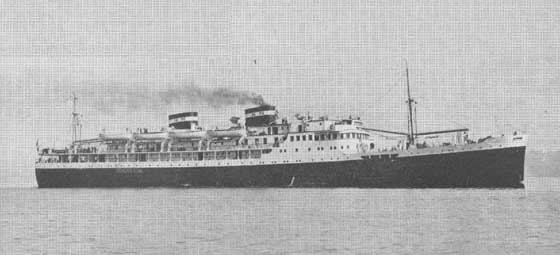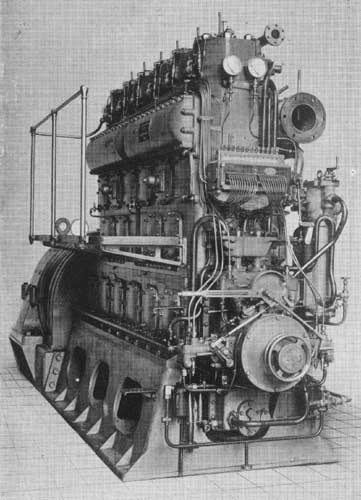
A publicity view of the El Mansour (Victorious in Arabic) in its original form with twin funnels. The funnel to the rear was a dummy, serving only to meet the design aesthetics of the time. It would later be removed and the height of the remaining funnel would be increased.
The contract for the El Mansour was signed August 17th 1931, under number 1212, between the Compagnie de Navigation Mixte and the builder Forges et Chantiers de la Mediterranee. The ship was launched on October 22nd 1932 from the builders yard at at La Seine sur Mer. This was the largest ship built for the company to date, joining it would be a sister ship - the El Djezair. Trials were performed during March 1933, operating up to the speed of 22.60 knots. It was delivered on April 29th 1933 and went into service on May 21st 1933 on routes very familiar to the Compagnie de Navigation Mixte. Routes travelled included:
Marseille to Tunis
Port Vendres to Algiers
Port Vendres to Oran
Marseille to Philippeville & Bone
Marseille to Algiers
The ship was powered by two Parsons turbines, single reduction gear, with an output of 12,000hp at 180rpm. At a service speed of 20 knots which equalled a power output corresponding to 8,500hp at 160rpm, with fuel consumption at 5,050 lbs per hour. Some of the auxiliary power was provided by two Sulzer 6RKHP25 engines, each producing 300hp at 375rpm. The auxiliary generator sets were built by Forges et Chantiers de la Mediterranee.
For the most part the El Mansour went about its business with little to distinguish one trip from the next, but from time to time unusual events involved the ship. On July 4th 1935 an Italian seaplane crashed into the Gulf of Lions, the El Mansour came to the rescue of the passengers and crew.
During 1937 modifications were carried out on the ship. Most noticeable was the removal of the rearmost 'dummy' funnel, and the increase in height of the remaining funnel. The original short funnel had caused smoke to bother passengers at the rear of the ship.
The Spanish Civil War which had commenced during July 1936 had an impact on the routes taken by the El Mansour. From 1936 to 1939 about ninety foreign flagged ships were lost in the conflict, from small luxury yachts to 10,000 ton tankers. France had initially signed the September 1936 Non-Intervention Agreement but the wavering fortunes of the elected governments in power during this period eventually resulted in February 1939 in the French government recognising General Franco as the new ruler of Spain. From April 20th 1937 to October 1939 the Company ships would carry the French colours for neutrality, with a Tricolor painted on each side of the bridge. On February 18th 1938 whilst sailing between Barcelona & Majorca a shell fell in the sea about 150m off the El Mansour's port bow, the ship was unharmed by this near miss and continued its journey escorted by the destroyer La Palme.
Whilst docking at Port Vendres? on February 12th 1938 the ship hit a destroyer and then the dock itself, causing damage to both sides of the ship.
In September 1939 the El Mansour assisted with the transport of troops between Algeria, Morocco, Lebanon and France. In October 1939 it was requisitioned by the Navy and converted into an auxiliary cruiser and renamed X6. The changes were made at FCM (La Seyne sur Mer), armament being added, which included 7 x 138 mm guns, 2 x 75 mm AA machine guns and four 13.2 mm guns. The ship would be allocated to the First Division which included sister ships the 'Kantara' & 'El Djeza´r'.
During the second week of April 1940 the El Mansour took on equipment and troops at Brest, to become part of the Allied landings at Namsos, Norway during April/May 1940 in an attempt to interrupt the flow of iron ore to Germany. With four destroyers and the cruiser Emile Bertin as escorts the force moved to Greenock and then Scapa Flow. On April 19th two battalions of the French Alpine troops landed at Namsos whilst under heavy air attack. The size of one of the French transports was too long to enter the harbour, so returned to the United Kingdom with many badly needed supplies still on board. This lack of equipment hindered the French troops on the ground, however they would be part of the force covering the retreat of Allied forces back to Namsos prior to evacuation. The French First Division completed its return safely with the El Mansour conveying 1,350 French of the 67th Bt Alpine Hunter, and 323 British soldiers.
The First Division was also involved in the repatriation of French troops evacuated from Dunkirk, from England back to France (did this include the Mansour?). Additionally the El Mansour was involved in the movement of the gold of the Bank of France, which had been temporarily stored at Brest. On June 18th 1940 1,200 tons of ingots were loaded and shipped to the West African port of Dakar, arriving on June 25th 1940. The movement of the gold was two fold, firstly to keep it out of the hands of the Germans and secondly should France fall, consideration was given to the French government continuing to fight the war from one of its territories in North or West Africa.
Its continued role as an auxiliary cruiser was shortlived, the lack of fuel after the June 1940 Armistice led to the El Mansour being disarmed at Wilson Quay, Marseilles. It was later requisitioned by the Germans on January 9th 1943 who permitted its use by the Italians, who renamed it Amagni, however after the surrender of Italy the ship was taken back by the Germans for further use, but later stopped in Marseilles. It was here on August 22nd 1944 that the ship was scuttled by the Germans at Pier H. It sank in 12 meters of water, capsizing to port with a list of 85 degrees.
After the end of World War II the Bees Chambon Union Company set about recovery of the ship. They were not helped by the discovery of 2,300 tons of rubble in the vessel. Hoists, floats and the crane barge Samson were used to help right the ship between November 15th 1945 & October 3rd 1946. After a brief cleaning it was towed to La Ciotat in early November 1946. Here the ship was completely stripped of everything apart from some engine compenents. Since the ship had sunk onto its port side, this side was distorted and contained holes.
In the rebuilding of the ship many changes were made. The front half of bridge deck was lowered, the masts were altered and two lifeboats were removed. Deck openings were removed to increase crew accommodation and the screened portion of the promenade and boat deck was lengthened. The new details were:
Tonnage 5818; net tonnage 2434; displacement 5750; deadweight 1545; other dimensions remain unchanged.
Passengers: 2 deluxe; 12 priority; 52 1st class; 268 tourist class, 530 4th class (steerage).
Whilst at La Coitat the El Mansour was moored alongside the La Marseillaise which was also present for reconstruction. During a storm on the night of September 25/26th 1947 both ships broke free from their moorings and crushed over forty small craft/fishingboats.
The El Mansour resumed service on September 5th 1948 on the Port Vendres - Algiers route.
During March 1949 it was honoured by the Bank of France as one of (and only remaining representative of) the 1st DCX auxiliary cruisers. Later that year, on November 24th 1949 it began four months of repairs at La Seyne, returning on April 6th 1950 to the Marseille route.
In 1955 its capacity was increased to carry more cars and changes were made to improve its unloading/loading capabilities. During November 1956 whilst on the Algiers to Port Vendres run a fire broke out in a cargo of cork, the El Mansour returned to Algiers to have the fire extinguished. The damage sustained was of a minor nature, with the ship sailing the next day to Port Vendres.
From December 1956 to early March 1957 the ship was berthed at Forges & Chantiers de la Mediterranee in La Seyne sur Mer for engine repairs (boilers and tubes).
Following the Algerian vote for independance during July 1963, a mass exodus began of the French and other Europeans, many of whom might have sailed between Algiers & France on the the El Mansour or her sisters. However by this time the age of the ship and the loss of traffic, due to size and other reasons was causing operating concerns, the company's fleet of ships were too large for the routes now being operated. Its last voyage was from Marseilles to Bone on October 22-25th 1963.
The ship was quickly purchased, on October 28th 1963, by the French Navy for use as a depot ship, leaves Marseilles on October 31st 1963 for Brest. Changes made included the removal of two boilers, with accommodation established to house 250 staff of the Experimental Center of the Pacific. The bridge was raised and a deckhouse built to the rear of the lifeboats. The hull was repainted white and now operating under hull number A-611 Maine. These changes reduced the maximum speed to 15 knots, with the engines now producing 7,500hp, the displacement was new 5,420 tons.
After having spent much of its life operating in the Mediterranean the Maine made a lengthy voyage to Tahiti for its new assignment. It would become a floating hotel at Mururoa Lagoon or Fangatanfa for the staff involved in the French nuclear testing program. It would remain on these duties until retired from service early in January 1974. For its final demise the ship was not sent to a breakers yard, instead at noon on April 3rd 1974 the Maine was deliberately sunk by the escort sloop Doudart Lagree. Ironically the demise of the Doudart Lagree would be very similar, it was used in target practice being sunk on November 29th 1999 by the French Navy frigate Latouche-Treville off the coast of Brest.
Details
Displacement: 5,730 tons, 2,800 tons net, deadweight 1,555 tons
Length: 121.70m
Beam: 16.47m
Draught: 5.52m
Propulsion: 2 Parsons Turbines at 8,100rpm: indicated 12,000hp; four boilers
Propellers: two
Speed: 20 knots
Passengers: 4 luxury; 17 priority; 90 1st class, 142 2nd class, 126 3rd class
Crew: 97


Two views of one of the model 6RKHP 25 producing 300hp at 375rpm, on the El Mansour these were each coupled to a generator used to provide electricity for the ship. The RK series engines were a development from the earlier RV models. The RK series were built between 1925 and 1955, with over 1,900 entering service. The early examples had indirect fuel injection with pre-combustion chambers. However by the time the 6RKHP models were built for the El Mansour direct injection was used. They were frequently used for marine propulsion, or use as marine auxiliaries. Elsewhere they were used for stationary drives in factories and for electrical power generation
Sources:
Extract 'Marines guerre et commerce' No.12 March 1991 (author Bernard Bernadec).
Publicity material: 'Moteurs Marins Diesel Sulzer' by Forges et Chantiers De La Mediterranee.
From the Mountains to the Seas - The Sulzer Diesel Engine by Jack A Somer & Helmut Behling.
Page added March 11th 2011.
Return to Ship menu
Return to site menu